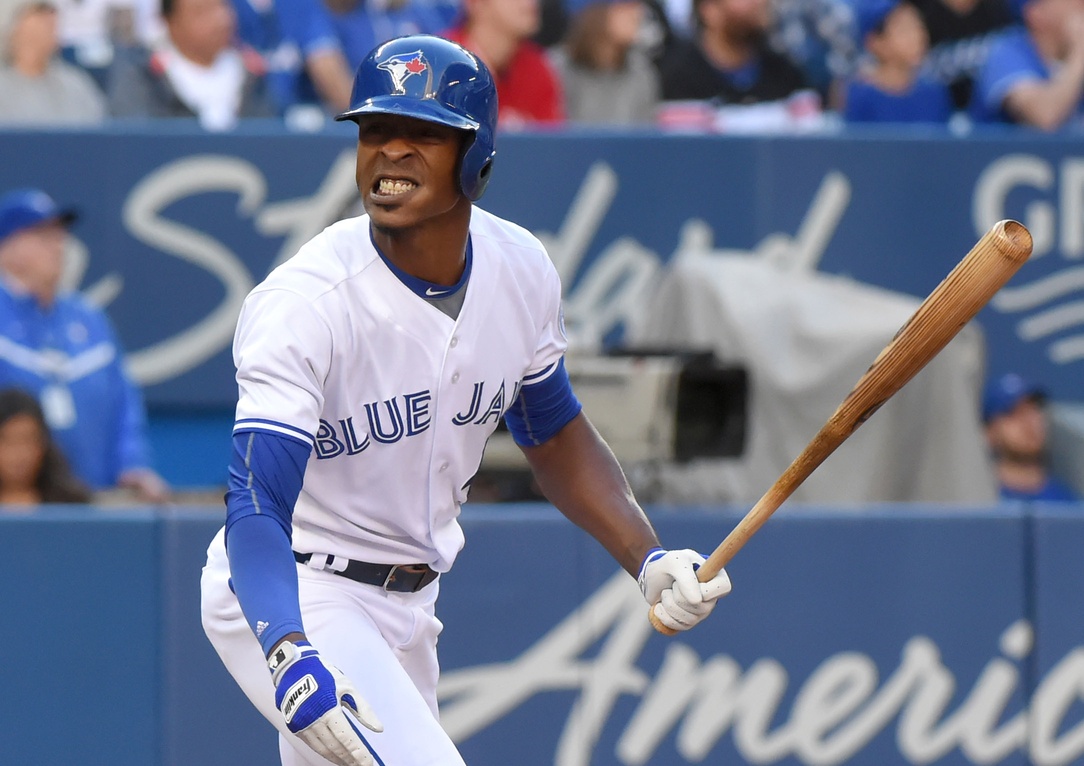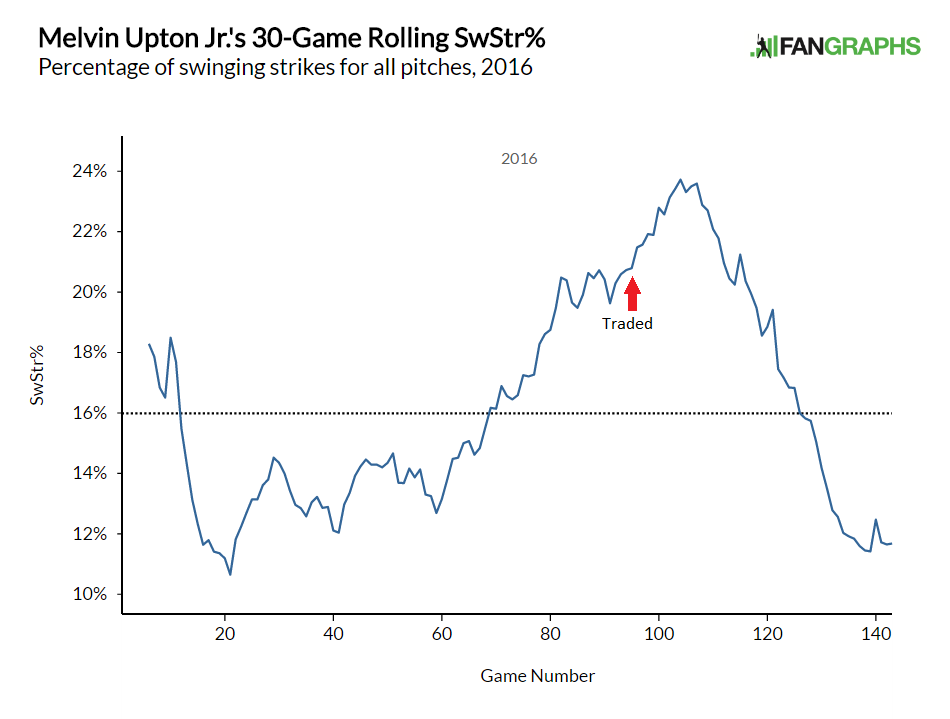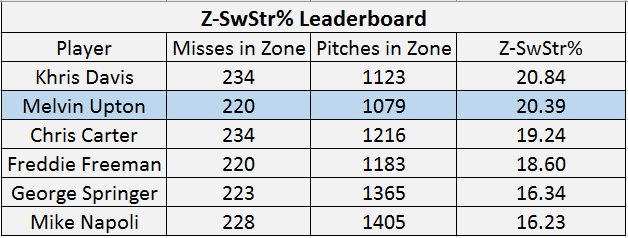When the Jays traded for Melvin Upton Jr. at the deadline, they knew what they were getting into: great speed, good defence, some power, and a ton of whiffs. All the whiffs. The defence and speed were put on display from the get go, but the whiffs were beyond what anybody could have expected. Through his first 15 games in Toronto, Upton posted a .136/.170/.307 line with 18 strikeouts in just 44 at-bats. That’s a 38 percent strikeout rate, and all those whiffs raised his SwStr% from 20.6 to a season-high of 23.7 over that period.
Since that peak on August 12, however, it’s been a different story.
Since that date, his triple slash has been a less-dismal .227/.306/.412, but more importantly his SwStr% has plunged and he has only struck out in 25 of his plate appearances. This has been an incredibly valuable development for the Jays, as it has allowed Gibbons to use Upton as a pinch-hitter or defensive replacement with much more confidence.
Nobody’s saying he should be starting crucial games. But if that trend is real he could be a sneaky X-factor if the Jays squeeze into the playoffs. Swinging strikes were a big problem for Upton that is now it looks like he’s on his way towards solving.
That’s according to SwStr%. Which is a great statistic, but it doesn’t give you the full picture. There’s a difference between a swinging strike on a pitch in the zone and on a pitch out of the zone. It’s why we differentiate between Z-Swing% and O-Swing% (zone and out of zone) when we already have Swing%. So since, for some reason, I care enough about Melvin Upton Jr., I calculated his Z-SwStr% and his O-SwStr% before and after August 12 to get a better idea of where he’s made his whiff reductions.
For reference, the average SwStr% in 2016 is 10.1%. The number that jumps out from that table is the fact that Upton has cut his swings and misses out of the zone by nearly half. He also improved his Z-SwStr%, but the bulk of his SwStr% reduction can be attributed to his out of the zone swinging strike rate.
And that makes a lot of sense, because the Melvin Upton Jr. we’ve seen with our own eyes has been defined by how shockingly often he swings through strikes. His swing is pretty, no doubt, but it’s also long, and I can’t count the number of times I’ve groaned audibly after he misses a hittable middle-middle fastball. Actually, I can count.
That’s 220 whiffs in the zone. Only Khris Davis has a higher Z-SwStr% than Upton. Limiting the scope to just fastballs, Upton’s 21.5 Z-SwStr% is the highest in all of baseball this year. With his whiff woes on pitches out of the zone solved, if I’m pitching to Upton right now, my game plan would be hard fastballs in the zone. His dramatic Z-SwStr% improvement has shown that he’s laying off the junk pitches well, but he’s still pretty likely to swing and miss if you challenge him.
In fact, that’s precisely the game plan that several observant pitchers have gone with against Upton this season.
Exhibit A
That might look like a GIF of one pitch, but it’s actually a GIF of an entire Melvin Upton Jr. at-bat:
- 95 MPH fastball – swinging strike
- 94 MPH fastball – swinging strike
- 95 MPH fastball – swinging strike
I can only imagine this was the conversation between Mychal Givens and his manager before he came on in relief of Yovani Gallardo:
Givens: So what’s the scouting report on this guy, Buck?
Showalter: Throw strikes, change speeds.
Givens: You mean mix in my changeup?
Showalter: No like change speeds by 1 MPH that’ll do it.
And if you think this was a one-time oddity, you would be wrong. Upton has struck out on three consecutive whiffs in the zone three other times. If you don’t need them to be consecutive, then he’s done it five other times.
Exhibit B
Nick Vincent misses with two cutters outside to fall behind 2-0. Then:
- 90 MPH fastball – swinging strike
- 90 MPH fastball – swinging strike
- 91 MPH fastball – swinging strike
Sure, he reached back for some extra gas on the last strike, and you could argue it was well-placed, but Upton took three healthy cuts and was nowhere close to making any contact at all.
Exhibit C
Scherzer, like Vincent, falls behind 2-0 before getting down to business:
- 94 MPH fastball – swinging strike
- 94 MPH fastball – swinging strike
- 87 MPH slider – swinging strike
The precision of Scherzer’s command is visual poetry. The last pitch is a slider, which takes away some of the velocity and adds some movement, but it’s still just another pitch in the zone that Upton swings right through.

The at-bat against Vincent is the most troubling example because A) Vincent doesn’t throw all that hard, and B) Upton was being used as a pinch-hitter in a tie game.
The Verdict
We can draw positive takeaways from Upton’s improving overall contact rate, but that doesn’t mean we should feel comfortable with Gibbons using him in a high leverage situation against a pitcher who’s not afraid to challenge him in the strike zone with fastballs.
It’ll be interesting to see whether his dip in out of the zone miss rate will eventually be followed by one for pitches in the zone. My gut says that there are different factors contributing to each. Chasing has more to do with pitch recognition and reading the pitcher’s plan. Hitting pitches in the zone is bat speed, timing, and length of swing. Devon Travis, for example, has a 6.7 Z-SwStr%. His compact swing is perfect for spoiling good pitches, and his bat speed is impressive. Upton’s swing is the polar opposite: loopy and lagging.
The out of the zone improvement will help him get into good counts, but when that 3-1 fastball comes down the pipe, don’t expect Upton to hit it.
Lead Photo: Dan Hamilton-USA TODAY Sports



